Discover how to test eggs for freshness and never second guess how fresh your eggs actually are! There is not only one egg test for freshness, but in fact several reliable methods we can use to test eggs for freshness.
This post may contain affiliate links at no additional cost to you. By making your purchases through the links on this website, IMSL may make a small percentage at no direct cost to you. IMSL only promotes products we use & truly believe in. Please refer to my Privacy & Disclosures for further information. IMSL thanks you for your support!
If you are not blessed to own and raise your own laying hens, I’m sorry. No, literally, very sorry.
There may be nothing as divine as gathering your own fresh eggs straight from the coop one minute and making something delicious with them the next.
When you raise your own ladies, very rarely does the need arise to test eggs for freshness. Unless of course they like to hide them 😅
Layers who have the luxury of free-ranging (not in an enclosed pen) often will lay in some pretty interesting area’s. These yard eggs are most likely fine to consume, but using an egg test for freshness is a sure fire way of determining the eggs age.
Purchasing eggs, however, is a different story. Knowing the “use by” date listed on purchased egg cartons is one key piece of information. That information though does not indicate the level of freshness, typically just a date in which it is recommended they be consumed.
Raise your hands if you actually look at the dates listed (look here to decipher what those numbers actually mean), consume them right upon purchase (or do they remain in the fridge for a bit?), or just assume that eggs pretty much last forever when refrigerated?
Sadly, my friends, eggs don’t last forever. Learning how to test eggs for freshness is a great way to determine just how old an egg actually is.
WHY FARM FRESH EGGS LAST LONGER
You may have heard of some storing fresh eggs on their counter for an extended period of time. Although this may seem counterintuitive, leaving eggs at room temperature is an acceptable storage method for freshly laid eggs. With a few stipulations.
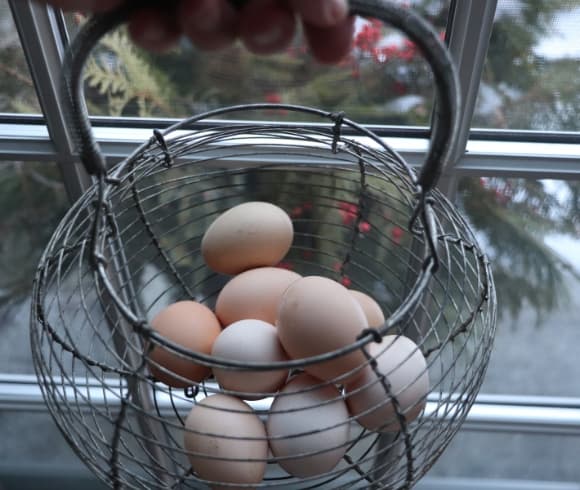
Why? Because of the natural “bloom” surrounding eggs.
WHY THE EGG BLOOM MATTERS
This egg bloom, often referred to as the cuticle, creates a natural protective layer, film, or covering surrounding the egg. Hens produce the bloom as a last layer on the outer egg shell just prior to laying.
The bloom not only prolongs the shelf-life of the egg, but also protects it from unwanted bacteria entering the egg. Eggs are extremely porous, 6000 to 8000 shell pores per egg! The production of the bloom essentially blocks these pores, sealing them from exposure to bacteria.
Eggs are, after all, a birthing center for potential baby chicks. Its shell is designed to protect and ensure the well-being of the fertilized embryo.
During the laying process the egg will pass straight through the cloaca, also the area in which fecal and urinary material passes. The bloom protects any bacteria from entering and harming growing embryo’s.
Unwashed eggs with the bloom intact can be stored for up to two weeks at room temperature. Any longer than that, it’s recommended that they be stored in cooler temps like the refrigerator, lasting for upwards of 3 or more months.
As anyone who raises laying hens will tell you, it can be pretty hard to keep track of the age of eggs you have on hand. Especially during their most productive laying stage. Knowing how to test eggs’ freshness is a great way to ensure you are using the eggs efficiently!
WHY COMMERCIALLY PURCHASED EGGS NEED REFRIGERATION
Larger egg producers wash this natural bloom from the egg using chemical sanitizers which leaves the egg vulnerable to bacteria contamination.
Thus the need for immediate refrigeration at temps around 45°F to prevent the growth of any bacteria.
Purchased eggs without the bloom intact should remain viable in the fridge for only 3 to 5 weeks according to the USDA.
All the more reason to purchase local, pastured eggs from a trusted local source!
So how do we know the age or freshness of eggs? By performing a few simple tests.
METHODS FOR TESTING EGGS FOR FRESHNESS
When in doubt about your eggs level of freshness, fortunately we have several reliable methods available to use for testing those eggs for freshness!
- expiration dates
- float test
- smell test
- plate test
- shake it test
- lighting test
Tho’ I will say, some of these methods for testing your eggs freshness work much better than others 😉
HOW TO TEST EGGS FOR FRESHNESS
These methods for how to test eggs for freshness are pretty straight forward, no special equipment needed other than your sense of sight, smell, and hearing.
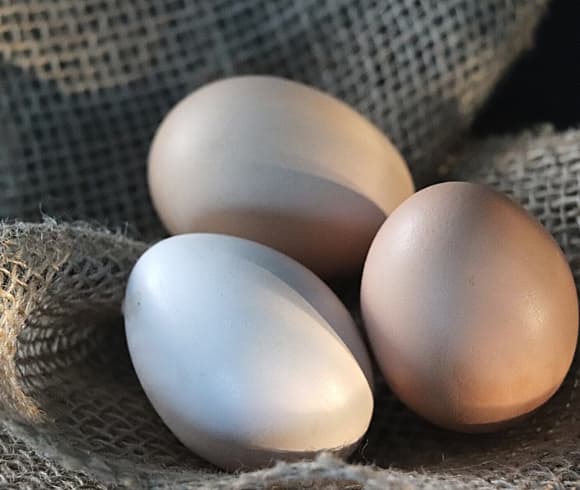
My favorite egg testing method? The water test, also known as the egg float test, but lets break down the process of how I test my eggs when needed for age.
CHECK PURCHASED EGGS CARTON INFORMATION FIRST
When you purchase your eggs the carton itself will give lots of information. Including the “used by” or “best by” date. When in question as to the age of your eggs, look to the carton first.
Here in the U.S. it’s good to note that according to the USDA, purchased eggs can be sold up to 30 days PAST their packaging date. This makes the potential for purchased eggs, even when bought prior to the use by date, going bad is much greater than that of local, farm-raised!
On a typical egg carton you will find not only the “best or use by” date, but also what is known as the Julian date as well as the plant or farm code.
The Julian date is a 3 digit code which refers to the actual day of the year (001 through 365) in which the eggs were packaged. January 1 referring to 001 and December 31 to 365.
The plant or farm code is usually alongside the Julian date and is often preceded by the letter “P”.
These dates with a little math, give a good indication to the approximate age of the eggs in question.
EGG TEST FOR FRESHNESS WITH THE FLOAT TEST
This method for determining the age of your eggs is by far the most reliable in my humble opinion 🤗
Use this method just prior to using your unwashed eggs remembering that any washing or submerging with water will remove any protective layer or bloom.
To utilize this testing method, fill a bowl or cup with room temperature water, making sure the water level is at least if not more 2X as deep as the egg is tall.
Place the egg in question gently into the water. The next 2 images show the extremes of both a very freshly gathered egg and one that is showing its old age.
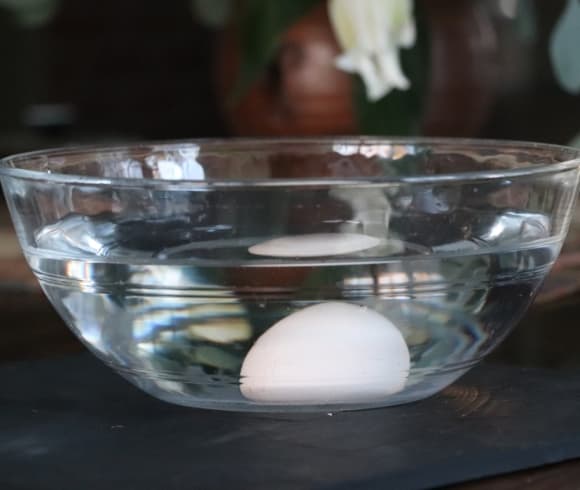
As you can see by the image below, old eggs which can potentially be considered “bad”, float. Note the small circled shape at the top of the egg. This egg is in the beginning stages of completely floating.
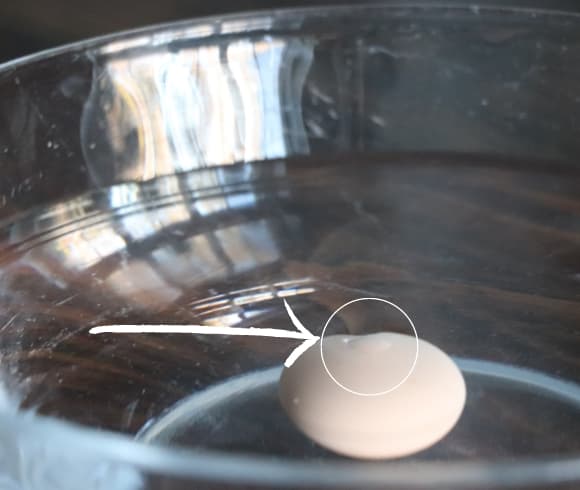
STEPS FOR TESTING EGGS FRESHNESS USING THE FLOAT TEST
- Fill a bowl or cup with room temperature water twice the depth as the eggs height
- Place the egg(s) in question into the water
- Using the graph below, determine the age of your eggs
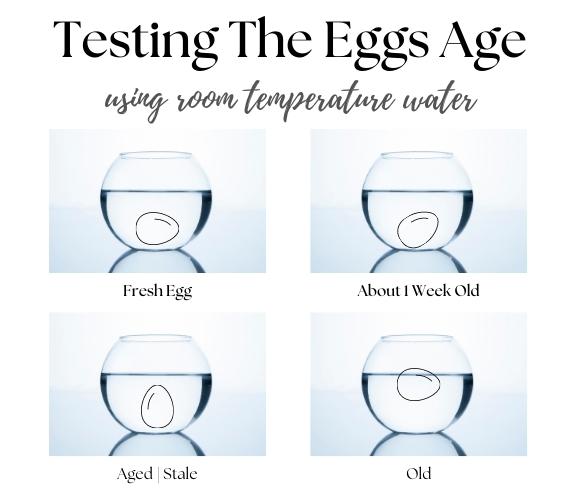
Should you have any floater’s you certainly have the option of discarding the egg into your compost bin. However, being the frugal New Englander that I am, I like to take the testing even further.
WHY THE FLOAT TEST WORKS
Not to get too “sciencey” (is that even a word?) but why does the float test work so well? It’s all about the porous egg shell.
Fresh eggs naturally have very little air within. As the pores of the shell are protected by the bloom or protective outer film, air does not penetrate easily into it.
Fresh eggs = little air = inability to float.
As the eggs age, overtime air begins to enter more easily to its inner world. As more air enters, the easier the egg begins to float.
Older eggs = more air = higher they float.
EGG TEST FOR FRESHNESS USING THE SMELL TEST
Testing eggs’ freshness with the smell test is not for the faint of heart.
I mean, have you ever smelled a rotten egg ??? 😅
Looking at the bright side, the intense, sulfur-like scent of a rotten egg is definitely a warning sign that your egg should not be consumed.
Should your egg fail the float test, break the egg open and give it a whiff. If it smells ok still, continue with further testing 👇🏻👇🏻👇🏻
TEST THE OPENED EGG USING THE PLATE METHOD
If the egg in question smells ok, test the opened egg using the plate method.
Gently pour the opened egg onto a plate by itself to visually take a look noting …
- YOLK – the yolk should remain round & remain in the center of the egg white (albumen), looking a beautiful yellow/gold color. It’s important to note that the color of the yolk may vary from a light golden color to a deep, orange. These color variations are due to the hens diet only, and should not be considered “bad”. When the yolk begins to look flattened in shape, this is a good indicator of an older egg
- ALBUMEN – The egg white or opaque portion of the egg should remain closely attached around the egg yolk, & should be firm and thick looking when fresh. If the egg white is runny, loose looking & not holding the yolk in place, it’s definitely older
TESTING EGGS FRESHNESS BY GIVING IT A SHAKE
As air enters the egg with age the sound begins to change from no sound whatsoever with a fresh egg, to movement or sloshing/swishing sounds indicating an older egg.
In a quiet space, hold the egg close to the ear and give it a shake. No sound, good to go. Noise, no go.
Does noise/movement mean it’s not safe to consume? No. Refer to the above testing methods for further investigation of any in question.
ARE OLD EGGS SAFE TO CONSUME?
Once you’ve completed the testing process and determined which eggs are older, are they safe to consume?
It really boils down to your comfort level. Would I consume store-bought eggs that are raised commercially when showing signs of being past their prime? Probably not.
Sharing Is Caring ❤️
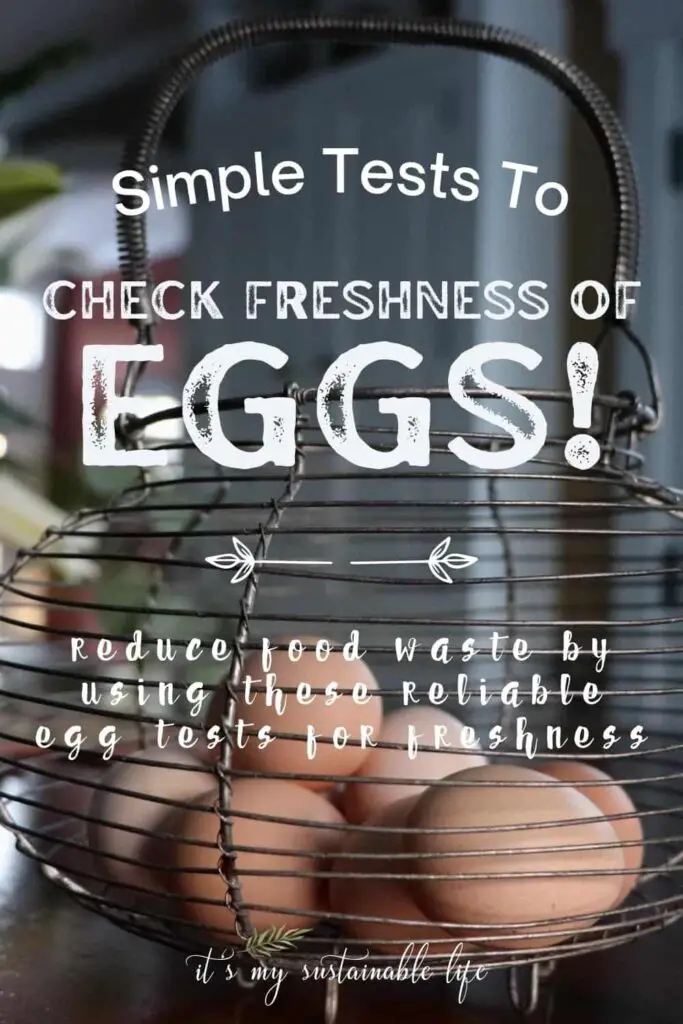
… and I thank you for it!
But I raise my own. For me, consuming eggs which have gotten older but show no indications it has gone bad are great for hard boiling. In fact, I often allow a few every so often to age for just that purpose.
WHY?
Because they peel so much easier due to the additional air which has entered into the egg itself.
INDICATIONS OF AN EGG GONE BAD
Nothing can beat visual & smell tests of eggs to determine freshness.
A few indications of an egg gone bad …
- COLOR – Should you find any areas where there are a few off color’s, think pink, green, brown, black & even iridescent discolorations anywhere on the white or yolk of a broken egg, don’t chance it, toss it
- SMELL – Again, an off scent is pretty distinguishable when it comes to eggs. Eggs are pretty scentless until they deteriorate. Any scent, toss it
- CRACKS & OTHER SIGNS – Cracks in the shell and/or sliminess are definite indicators that bacteria is present. Discard and do not use
- POWDERY APPEARANCE – Should the shell appear to have a powdery appearance, it may be an indication of mold. Discard
NOTE: Not ALL colorations within the egg are bad. Very dark brown or red specks of color floating amongst the white or adhered to the yolk do not mean the egg is bad. This just means it’s most likely fertilized or has a blood spot from a broken blood vessel. Eggs can only be fertilized from farms which house a rooster, commercially raised eggs will not have roosters present. These eggs are still viable and delicious to use.
HOW TO PROPERLY STORE EGGS
Storing eggs properly will ensure you have eggs available for a pretty long time!
HOW TO PROPERLY STORE COMMERCIALLY RAISED EGGS
When purchasing commercially packaged eggs, store them in the fridge in the carton they came in immediately upon arriving home.
Refrigeration temps should be 40°F or below, and the eggs placed in the coldest part of the refrigerator (hint: not the door as the temperatures will fluctuate) according to FSIS.
HOW TO PROPERLY STORE FRESH FARM EGGS
Storing fresh farm eggs properly is very different from commercially raised and processed ones.
First, get to know the farmer you are purchasing from and find out if they have washed the eggs or not AND if they have been refrigerated. I would also inquire as to the approximate time from gathering to selling they estimate.
If the eggs were previously refrigerated, they need to stay that way, even coming fresh from the farm. Moving & storing eggs from the refrigerator to the counter will cause sweating and increase the likelihood of moving bacteria into the egg.
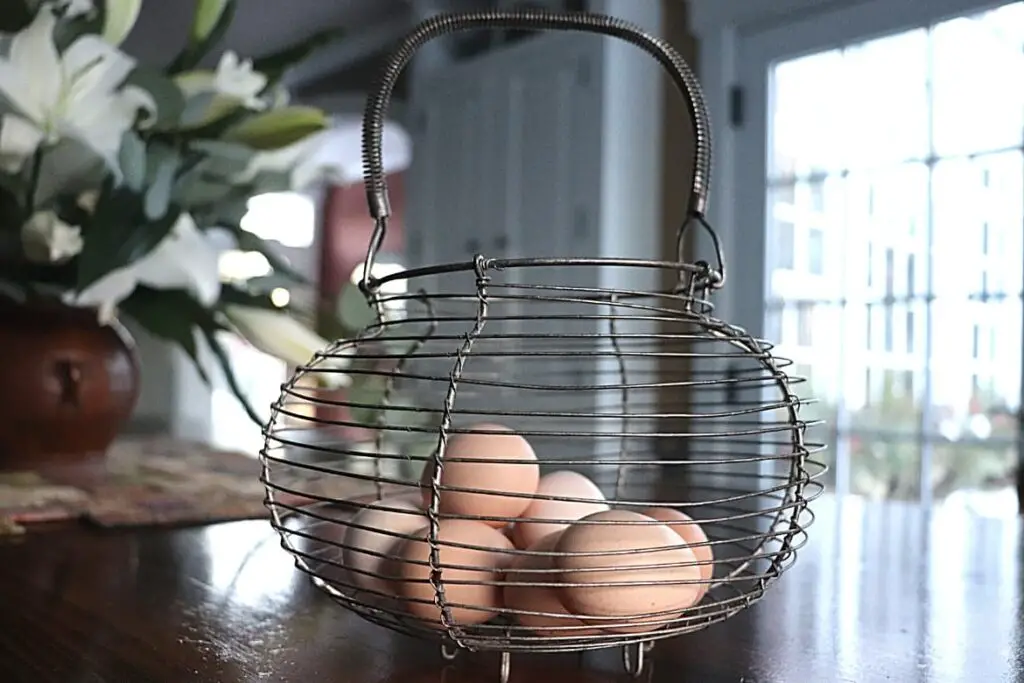
Unwashed eggs which have not previously been refrigerated may safely be stored unrefrigerated for about 2 weeks if they were gathered fairly recently.
After several weeks, be sure to refrigerate them for longer storage times of 3 or more months.
ALTERNATIVE STORING METHODS
Have some fresh eggs which you know will be expiring soon? Or have an influx of eggs and can’t use them all? Don’t want them to go to waste?
Freeze them!
Yup. Eggs freeze surprisingly well. And the entire, whole egg can be frozen. You have the option of separating the whites from the yolks if you like, but I find freezing the egg in its entirety as I don’t use a lot of recipes which call for separating.
To freeze, simply crack the eggs into a bowl, gently beat until barely mixed, and pour the slightly beaten egg mix into your favorite freezer containers. Be sure to mark your container with the number of eggs (ice cube trays work great with 1 cube = ½ whole egg) and the date they were frozen.
Do NOT try to freeze eggs in the shell or un-beaten. It doesn’t work.
Frozen eggs are great for making omelets, scrambled eggs as well as baking recipes.
EGG STORAGE CHART
| STATE OF THE EGG | COUNTER | REFRIGERATOR | FREEZER |
| Farm Fresh (Un-washed) | 2 Weeks | 2 to 3 months | |
| Farm Fresh (Washed) | 2 to 3 months or more | ||
| Commercially Purchased Eggs | 3 to 5 weeks | ||
| Older Eggs (Separated or Beaten) | 4 months to 1 year |
UNIQUE TIP FOR STORING EGGS
It’s suggested to always store eggs bottom’s up 😅. As in the round end pointing upwards and the pointy side pointing down.
Why?
There is an air sac or pocket located near the fat end of the egg. By storing fresh eggs with the rounded end upwards encourages this air sac to remain where it is and not move in a downward fashion toward the yolk.
This air sac will assist the yolk in remaining in the center of the egg, thus extending the shelf-life of the egg.
TIMELINE TIPS FOR USING AGING EGGS
Understanding the eggs age also affects how we use those aging eggs so we can enjoy the best flavor & texture they have to offer.
- FRESH FROM THE COOP – These newly gathered eggs are best for eating straight up, as in sunny side up that is 😅, over-easy and the like. These are the ones which are also best used when preserving for long-term use. Think pickling & water glassing here
- SEVERAL WEEKS OLD – Great for making any dish or bake in which the egg is disguised or not distinguishable. Omelets, scrambles, bakes and the like
- AGED – Aged (over 2+ weeks old), are ones which I hard boil, but uses for aged eggs which are still viable uses don’t stop there. These eggs are wonderful to enjoy poached, in frittatas, quiches, bakes and the like.
- OLD – Using old eggs which you know are likely to turn are the ones which you want to freeze. Don’t need any more frozen? Fertilize your garden with the shells, feed the shells back to your chickens (a great source of calcium) & even use them as a nourishing hair mask!
- TURNED – Eggs which have turned or gone bad, discard completely
GET CREATIVE & LABEL THOSE EGG CARTONS!
Tired of plain ole’ gray or brown egg cartons? Share your farm fresh eggs with others? Consider giving those egg cartons a sprucing up!
Labeling those cartons adds a bit of whimsy, and just puts a smile on my face
Easy to download, easy to print, and reusable year-to-year, I hope you enjoy using this egg carton label template as much as I do
Download yours by clicking the image below …
HOW TO TEST EGGS FOR FRESHNESS SUMMATION
Learning how to test eggs for freshness is made easy with these quick methods, ultimately reducing food waste by allowing you to utilize eggs which may have been in question but are still usable.
Taking it one step at a time, determining which egg test for freshness works best for you, will have those eggs in question, well, not in question any longer 😅
How do you test eggs for freshness?
Love, Light, & Laughter ~

SHOP THIS POST
Enjoy this article? Please consider sharing it on your favorite social media channel! Want more? Subscribe below for the occasional update with all the “happenings on the hill”!

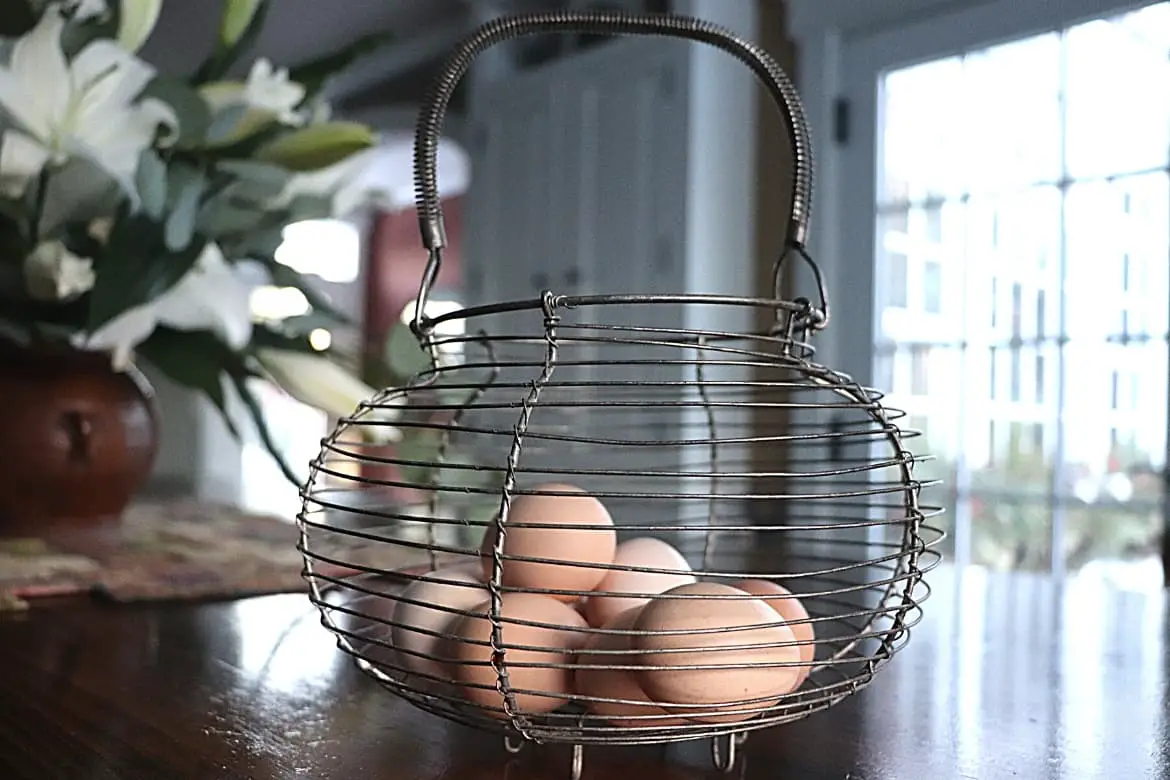
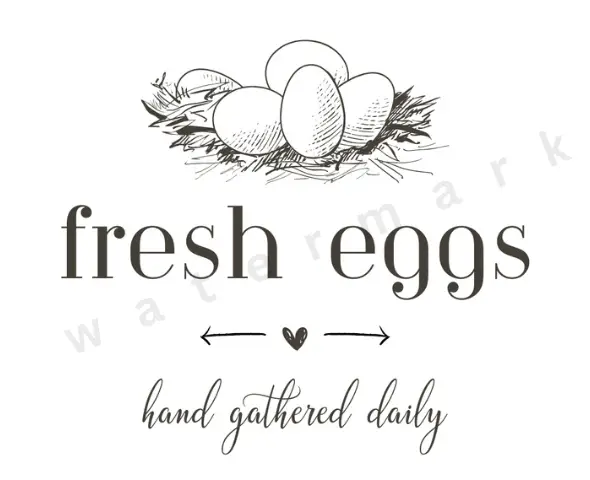

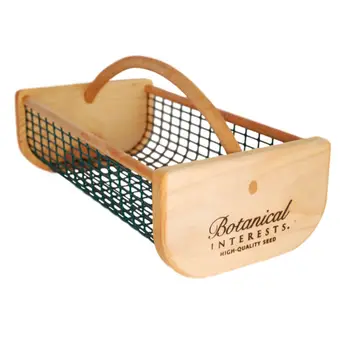
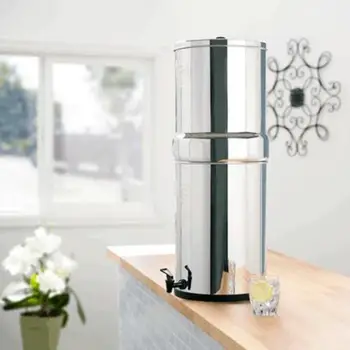
5 comments
I only knew the float or sink method for testing eggs for freshness! Great info.
The Float test is so cool! I am going to try it out!
Once you smell an egg that’s bad, you will never wonder if you need to check your egg for freshness. It is quite the smell.
LOL, ain’t that the truth!!
These are great ways to test an egg for freshness! I always knew about the float test, but never knew WHY it was a useful test. Seeing how porous the shell is makes sense!